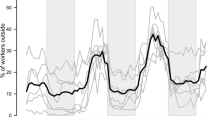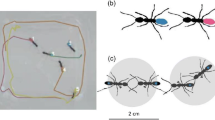Abstract
Workers of the speciesLeptothorax acervorum show age-polyethism, they start their life as broodworkers and later on they become nestworkers and foragers. Nestworkers and foragers of this ant species are inactive for 72% and 15% of the total time respectively. The short bursts of activity within the nest do not occur randomly but are synchronized so that the whole nest population exhibits nonperiodic pulses of activity: the ants were seen to wake each other actively.
In addition starvation experiments were done to assess whether ants react upon food availability. In appeared that during a longlasting period of starvation the proportion of active ants in the nest is at a higher approximately constant level.
Similar content being viewed by others
Literature
Allies, A. 1984. The cuckoo antLeptothorax kutteri: the behaviour and reproductive strategy of a workerless parasite, BSc. thesis, Uiversity of Bath.
Altmann, J. 1974. Observational study of behaviour: sampling methods.Behaviour 49, 227–265.
Bernstein, R. A. 1979. Schedules of foraging activity in species of ants.J. anim. Ecol. 48, 921–930.
Berridge, M. J. and P. E. Rapp. 1979. A comparative survey of the function, mechanisation and control of cellular oscillators.J. exp. Biol. 81 217–279.
BMDP. 1985.Statistical Software. University of California Press.
Bruyn, G. J. de and M. Kruk-de Bruin. 1972. The diurnal rhythm in a population ofFormica polyctena Foerst.Neth. J. Zool. 28, 117–127.
Buschinger, A. 1973. The role of daily temperature rhythms in brood development of ants of the tribe Leptothoracini (Hymenoptera: Formicidae). In:Effects of Temperature on Ectothermic Organisms, Ecological Implications and Mechanisms of Compensation, W. Wieser (Ed.).
Calabi, P., J. F. A. Traniello and M. H. Werner. 1983. Age polyethism: its occurrence in the antPheidole hortensis, and some general considerations.Psyche 90, 395–412.
Cole, B. J. 1981. Dominance hierarchies in Leptothorax ants.Science 212, 83–84.
Cole, B. J. 1986. The social behaviour ofLeptothorax allardycei (Hymenoptera: Formicidae): time budgets and the evolution of worker reproduction.Behav. Ecol. Sociobiol. 18, 165–173.
Elton, C. 1929.Animal Ecology. London: Sidgwick and Jackson.
Franks, N. R. 1987. The organisation of working teams in social insects.Trends Ecol. Evol. 2, 72–75.
Franks, N. R. 1985. Reproduction, foraging efficiency and worker polymorphism in army ants. In:Experimental Behavioural Ecology. Fortschritte der Zoologie Bd. 31, B. Hölldobler and M. Lindauer (Eds), pp. 91–107, Stuttgart Springer.
Franks, N. R. and S. Bryant. 1987. Rhythmical patterns of activity within the nest of ants. In:Chemistry and Biology of Social Insects, J. Eder and H. Rembold (Eds). Munich: Peperny.
Franks, N. R. and E. Scovell. 1983). Dominance and reproductive success among slave-making worker ants.Nature 204, 725–725.
Gordon, D. M. 1983. The relation of recruitment rate to activity rhythms in the harvester ant,Pogonomyrmex barbatus (F. Smith) (Hymenoptera: Formicidae).J. Kans. ent. Soc. 56, 277–285.
Gottman, J. M. 1981.Time Series Analysis: A Comprehensive Introduction for Social Scientists. New York: Cambridge University Press.
Hermerik, L., N. F. Britton and N. R. Franks. 1990. Synchronization of the behaviour within nests of the antLeptothorax acervorum (Fabricius)—II. Modeling the phenomenon and predictions from the model.Bull. Math. Biol. 52, 613–628.
Herbers, J. M. 1981. Time resources and laziness in animals.Oecologia (Berl.) 49, 252–262.
Herbers, J. M. and M. Cunningham. 1983. Social organisation inLeptothorax longispinosus Mayr.Anim. Behav. 31, 759–771.
Kalbfleisch, J. D. and R. L. Prentice. 1980.Statistical Analysis of Failure Time Data. New York: Wiley.
Kruk-de Bruin, M., L. C. M. Rost and F. G. A. M. Draisma. 1977. Estimates of the number of foraging ants with the Lincoln-index method in relation to colony size ofFormica polyctena.J. Anim. Ecol. 46, 457–470.
Lumsden, C. J. and B. Hölldobler. 1983. Ritualised combat and intercolony communication in ants.J. theor. Biol. 100, 81–98.
Oster, G. F. and E. O. Wilson. 1978.Caste and Ecology in the Social Insects. Princeton University Press.
Porter, S. D. and C. D. Jorgensen. 1981. Foragers of the harvester ant,Pogonomyrmex owyheei Cole, using a fluorescent marking technique.Ecol. Ent. 5, 263–269.
Schmid-Hempel, P. and R. Schmid-Hempel. 1984. Life duration and turnover of foragers in the antCataglyphis bicolor (Hymenoptera: Formicidae).Insectes soc. 31, 345–360.
Wallis, D. I. 1968. The foraging behaviour of the antFormica fusca.Behaviour 23, 149–176.
Wallis, D. I. 1968. The relation between hunger, activity and worker function in an ant colony.Proc. zool. Soc. Lond. 139, 589–605.
Whitford, W. G., P. Johnson and J. Ramirez. 1976. Comparative ecology of the harvester antsPogonomyrmex barbatus (F. Smith) andPogonomyrmex rugosus (Emery).Insectes soc. 23, 112–132.
Wilson, E. O. 1968. The ergonomics of caste in the social insects.Am. Nat. 102, 41–66.
Wilson, E. O. 1975.Leptothorax duloticus and the beginnings of slavery in ants.Evolution 29, 108–119.
Wilson, E. O. 1978. Division of labour in fire ants based on physical caste (Hymenoptera: Formicidae: Solenopsis).J. Kans. ent. Soc. 51, 615–636.
Wilson, E. O. 1980a. Caste and division of labour in leafcutter ants (Hymenoptera: Formicidae: Atta) I. The overall pattern inA. sexdens.Behav. Ecol. Sociobiol. 7, 35–37.
Wilson, E. O. 1980b. Caste and division of labour in leafcutter ants (Hymenoptera: Formicidae: Atta) II. The ergonomic optimization of leaf-cutting.Behav. Ecol. Sociobiol. 7, 157–165.
Wilson, e. O. 1984. the relation between caste ratios and division of labour in the ant genusPheidole (Hymenoptera: Formicidae).Behav. Ecol. Sociobiol. 16, 89–98.
Wilson, E. O. 1985a. Between-caste aversion as a basis for division of labour in the antPheidole pubiventris (Hymenoptera: Formicidae).Behav. Ecol. Sociobiol. 17, 35–37.
Wilson, E. O. 1985b. The sociogenesis of insect colonies.Science 228, 1489–1495.
Wilson, E. O. and T. Eisner. 1957. Quantitative studies of liquid food transmission in ants.Insectes soc. 4, 157–166.
Author information
Authors and Affiliations
Rights and permissions
About this article
Cite this article
Franks, N.R., Bryant, S., Griffiths, R. et al. Synchronization of the behaviour within nests of the antleptothorax acervorum (fabricius)—I. Discovering the phenomenon and its relation to the level of starvation. Bltn Mathcal Biology 52, 597–612 (1990). https://doi.org/10.1007/BF02462100
Received:
Revised:
Issue Date:
DOI: https://doi.org/10.1007/BF02462100




